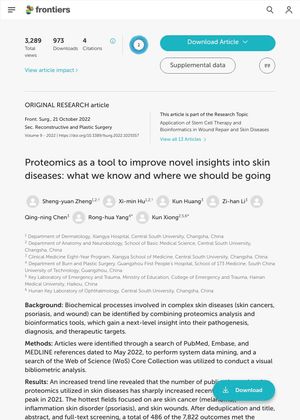Proteomics as a Tool to Improve Novel Insights into Skin Diseases: What We Know and Where We Should Be Going
October 2022
in “
Frontiers in Surgery
”

TLDR Proteomics combined with other technologies can lead to a better understanding of skin diseases.
The document discusses the use of proteomics, specifically mass spectrometry-based high-throughput proteomics, in understanding skin diseases, including skin cancer. Proteomics helps identify changes in proteins, explore functional changes in pathogenesis, and identify potential biomarkers such as HSPs, Survivin, CDK12, Vimentin, and Galectin-3 for skin cancers. The document also highlights the importance of bioinformatic platforms like KEGG, GO, and IPA in analyzing proteomic results. Proteomics has also been used to identify biomarkers for various skin conditions, such as Krt5 for acute alopecia and ALDH1 for atopic dermatitis. Despite its benefits, proteomics research faces challenges, including the need for large sample sizes and better understanding of the interface between different tissue sources. The authors conclude that proteomics, combined with other technologies, can lead to a more comprehensive understanding of skin diseases.



